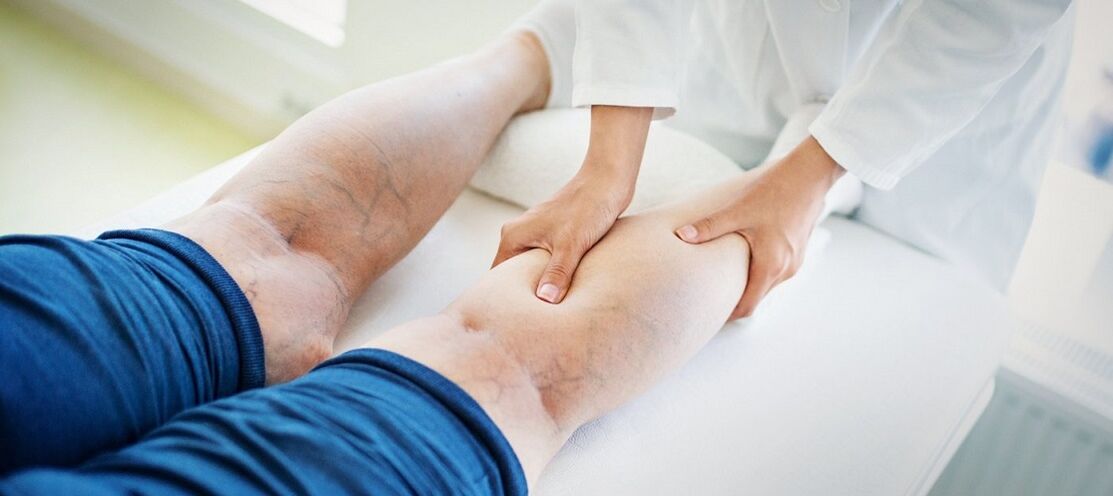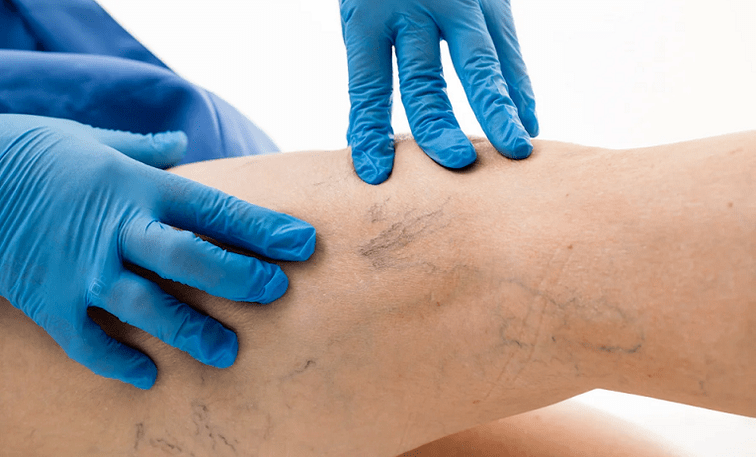
Varicose veins are not just an aesthetic problem, but a serious health threat. At the first signs of the disease, it is necessary to consult a doctor and begin treatment. According to statistics, 75% of women and 60% of men suffer from this pathology. The disease is insidious in that at the first stage the patient feels only a slight heaviness in the legs, without attaching much importance to this. For what reason varicose veins develop and how to treat it, we will tell you in this article. If you spend many hours on your feet and feel pain and swelling, then this information is a must-read.
What happens in the body during varicose veins?
Valves control the direction of blood flow in the veins. When they stop working properly, excessive fluid build-up occurs. As a result, the walls of the vessels stretch and lose their elasticity. Most often, varicose veins of the legs are found, because this part of the human body is more susceptible to great physical exertion. Superficial and deep veins are subject to changes over a large extent.
The reasons for the development of varicose veins
- pregnancy - there is strong pressure from the uterus on other organs, squeezing of blood vessels. A special load falls on the legs of a pregnant woman;
- after childbirth - improper tension;
- genetic predisposition;
- a sedentary lifestyle and little daily activity;
- endocrine diseases;
- overweight and obesity - the load on the legs increases;
- great physical activity - often those who cost a lot during the day suffer from the disease;
- age - the older the person, the weaker the vascular walls;
- high venous pressure;
- the development of chronic diseases;
- mechanical injuries of the extremities - disrupt the work of the vascular valves;
- taking hormonal drugs;
- hormonal changes (lactation period, menopause in women).
The predisposition to varicose veins is transmitted from parents and other relatives in a straight line. Genetic predisposition affects the development of pathology, even despite the lifestyle. If at least one of the parents is sick with varicose veins in the family, the probability of getting it in children is 60%, if both parents are 90%.
The first signs of the development of venous pathology
The very first symptom of varicose veins is pain in the legs by the end of the working day. This occurs when deep and superficial vessels change due to poor blood supply to soft tissues.
The pain can be different depending on the stage - at first it looks like ordinary fatigue, why there is a burning sensation in the legs, then pulling pain and cramps of the calf muscle. And, of course, the disease is accompanied by external changes. Blue bulging vessels or stars appear on the legs, depending on the stage. Also, the disease may be accompanied by swelling of the feet or ankles, discoloration of the skin over the affected vein.
The danger of the disease is not at all in edema and convulsions, but in a high probability of blood clots in the vessels. These are dense blood clots. They can "stick" to the vessel wall and narrow its lumen, or they can break off and travel with the bloodstream to other vessels, increasing the risk of blockage. This condition can even be fatal.

Stages of varicose veins on the legs
There are 4 stages in total, including:
- initial stagethe disease lasts for everyone in different ways - in some patients for several years, in others only a few months, and then passes into the next stage. Moreover, varicose veins can develop both in people of age and in young people.
The initial stage is manifested by fatigue and heaviness in the legs after a hard day's work. Swelling of the feet, ankles and lower leg may be present, spider veins appear on the legs, night cramps in the calves and pain along the veins. This stage is also called superficial due to the formation of vascular cobwebs. Often these symptoms resolve after a night's sleep. In some patients, symptoms are exacerbated both in bad weather and after intense exertion.
You should not wait until the disease passes into the second stage and more painful and unpleasant symptoms appear. Better to see a doctor right away. He will diagnose and prescribe treatment.
- Stage 2- has more pronounced symptoms. After a long sitting or standing position, nodules begin to appear and veins are felt. At this stage, there is a high likelihood of blood clots forming.
The doctor may recommend 2 methods of treatment: medication or surgery. In the first case, ointments, topical gels with anti-inflammatory and analgesic effects, tight-fitting stockings, elastic bandages and drugs to improve blood circulation are used. In the second, the removal of swollen veins using a laser or radiofrequency coagulation.
- Stage 3- a more complex form of the disease, in which it is simply impossible not to notice something amiss. To all the signs are now added the strongest edema of the limbs, which does not go away in the morning, the outflow of venous blood is disturbed, long non-healing trophic ulcers on the legs are formed, and a strong bulging of the veins.
The patient at this stage often complains of dry skin and the formation of cracks of different depths on the legs. These symptoms of pathology pose a great danger to human health, so you should immediately consult a doctor.
At the stage of decompensation, as it is also called, it makes no sense to carry out conservative treatment, only surgery can help the patient. During such an operation, the affected veins are removed. Blood passing through the removed vessel will be redistributed to deep veins, which will quickly become accustomed to increased stress.
- Stage 4- At the fourth stage of varicose veins, not only the vessels of the legs are severely affected, but also the skin of the lower extremities. It becomes dehydrated, excessively dry, microcracks of various depths form on it. The skin on the legs may turn dark in color. Skin atrophy appears. Trophic ulcers stop healing.
The only possible treatment option that can be used at the last stage of the disease is surgical treatment followed by the use of drugs. After treatment, the patient takes blood thinners and uses ointments to relieve local inflammation.
How is varicose veins diagnosed?
At the first examination, the doctor will talk with the patient and determine the combination of factors that led him to the development of the disease. Then the specialist will send for laboratory tests: blood and urine tests, which can provide the necessary information about diseases of internal organs, metabolic disorders, lack of vitamins and minerals, water retention in the body, which leads to vascular pathologies.
Among the hardware research methods, ultrasound of the veins of the lower extremities is used, namely, Doppler ultrasound (a method that allows assessing the patency of vessels, valves) or ultrasound angioscanning (in the presence of complications), computed tomography and MRI of the veins of the lower extremities.
Treatment methods for varicose veins
In the initial stages, pathology can be treated with conservative therapy using medicines for varicose veins. For this, anticoagulants are used (reduce blood viscosity and improve tissue nutrition), antiplatelet agents (reduce the risk of thrombus formation and improve tissue trophism), venotonics (prevent further stretching of the veins, reduce inflammation and swelling).
At later stages, they resort to the use of surgical intervention. Modern operations, which are carried out using a laser, radio frequency method or sclerotherapy, are performed under local anesthesia. Their goal is to close the affected vein. Blood will begin to pass through healthy deep vessels to the heart, which are extremely rarely prone to varicose veins - they are thicker and stronger.
It is important during treatment to use compression stockings that compress the legs and physically prevent the veins from swelling. Over time, it stretches, so after a few months it needs to be changed.
The patient needs to load himself up with little physical activity - light exercise or walking. Muscles that continually contract when walking help pump blood up to the heart and relieve congestion.
Disease prevention
Doctors recommend adhering to a few simple rules to avoid the appearance of an unpleasant ailment:
- Try not to sit or stand in one position for a long time, move more and be outdoors more often. Physical activity is the best prevention of varicose veins.
- When resting after a working day, lift your legs up - this will relieve pain and help proper blood flow.
- It is better to constantly keep yourself in shape and prevent the appearance of obesity, we have already said above that being overweight is one of the causes of pathology.
- Wear loose-fitting clothes made from natural fabrics - don't put too much pressure on your legs with tight trousers.
- High-heeled shoes should be discarded or worn less frequently. Any shoes you wear should not squeeze too much of the foot and lower leg. It is advisable to use instep support insoles.
- Avoid hot and long baths. They help to reduce venous tone.
- Eat a healthy diet and quit bad habits. It strengthens blood vessels, reduces blood viscosity, lowers blood pressure.
- Every morning you can do gymnastics, it helps to tone all the muscles.






























